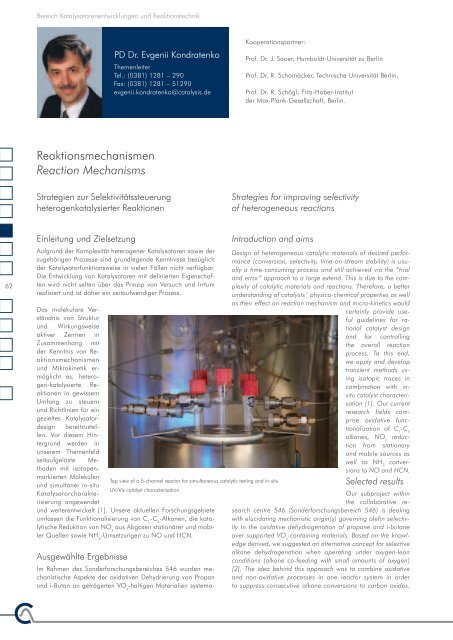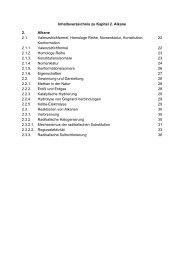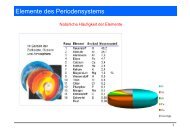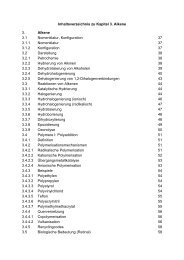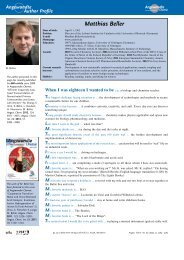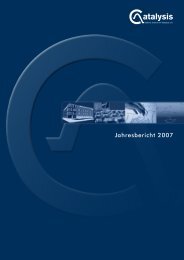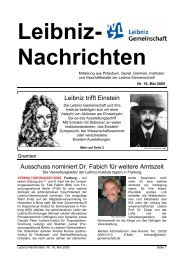An Overview of the Department's Activities - Leibniz-Institut für ...
An Overview of the Department's Activities - Leibniz-Institut für ...
An Overview of the Department's Activities - Leibniz-Institut für ...
Sie wollen auch ein ePaper? Erhöhen Sie die Reichweite Ihrer Titel.
YUMPU macht aus Druck-PDFs automatisch weboptimierte ePaper, die Google liebt.
Bereich Katalysatorenentwicklungen und Reaktionstechnik<br />
Reaktionsmechanismen<br />
Reaction Mechanisms<br />
PD Dr. Evgenii Kondratenko<br />
Themenleiter<br />
Tel.: (0381) 1281 – 290<br />
Fax: (0381) 1281 – 51290<br />
evgenii.kondratenko@catalysis.de<br />
Strategien zur Selektivitätssteuerung<br />
heterogenkatalysierter Reaktionen<br />
Kooperationspartner:<br />
Pr<strong>of</strong>. Dr. J. Sauer, Humboldt-Universität zu Berlin<br />
Pr<strong>of</strong>. Dr. R. Schomäcker, Technische Universität Berlin,<br />
Pr<strong>of</strong>. Dr. R. Schögl, Fritz-Haber-<strong>Institut</strong><br />
der Max-Plank-Gesellschaft, Berlin.<br />
Strategies for improving selectivity<br />
<strong>of</strong> heterogeneous reactions<br />
Compared to <strong>the</strong> oxidative i-C H dehydrogenation, O -lean conversion <strong>of</strong> i-C H to i-C H has been found as an<br />
4 10 2 4 10 4 8<br />
efficient approach for i-C H functionalisation<br />
4 10<br />
tisch untersucht, um die Ursprünge der selektiven und nicht- For example, i-butene yields above 40 % at i-butene selectiv-<br />
62<br />
Einleitung und Zielsetzung<br />
Introduction and aims<br />
Aufgrund der Komplexität heterogener Katalysatoren sowie der Design <strong>of</strong> heterogeneous catalytic materials <strong>of</strong> desired perfor-<br />
zugehörigen Prozesse sind grundlegende Kenntnisse bezüglich mance (conversion, selectivity, time-on-stream stability) is usu-<br />
der Katalysatorfunktionsweise in vielen Fällen nicht verfügbar. ally a time-consuming process and still achieved via <strong>the</strong> “trial<br />
Die Entwicklung von Katalysatoren mit definierten Eigenschaf- and error” approach to a large extend. This is due to <strong>the</strong> comten<br />
wird nicht selten über das Prinzip von Versuch und Irrtum plexity <strong>of</strong> catalytic materials and reactions. Therefore, a better<br />
realisiert und ist daher ein zeitaufwendiger Prozess.<br />
understanding <strong>of</strong> catalysts´ physico-chemical properties as well<br />
as <strong>the</strong>ir effect on reaction mechanism and micro-kinetics would<br />
Das molekulare Ver-<br />
certainly provide useständnis<br />
von Struktur<br />
ful guidelines for ra-<br />
und Wirkungsweise<br />
tional catalyst design<br />
aktiver Zentren in<br />
and for controlling<br />
Zusammenhang mit<br />
<strong>the</strong> overall reaction<br />
der Kenntnis von Re-<br />
process. To this end,<br />
aktionsmechanismen<br />
we apply and develop<br />
und Mikrokinetik er-<br />
transient methods usmöglicht<br />
es, heteroing<br />
isotopic traces in<br />
gen-katalysierteRe- combination with inaktionen<br />
in gewissem<br />
situ catalyst characteri-<br />
Umfang zu steuern<br />
sation [1]. Our current<br />
und Richtlinien <strong>für</strong> ein<br />
research fields com-<br />
gezieltes Katalysatorprise<br />
oxidative funcdesignbereitzusteltionalization<br />
<strong>of</strong> C -C 1 4<br />
len. Vor diesem Hin-<br />
alkanes, NO reduc-<br />
x<br />
tergrund werden in<br />
tion from stationary<br />
unserem Themenfeld<br />
and mobile sources as<br />
zeitaufgelöste Me-<br />
well as NH conver-<br />
3<br />
thoden mit isotopensions<br />
to NO and HCN.<br />
markierten Molekülen<br />
Top view <strong>of</strong> a 5-channel reactor for simultaneous catalytic testing and in-situ<br />
und simultaner in-situ<br />
Selected results<br />
UV/Vis catalyst characterisation<br />
Katalysatorcharakte-<br />
Our subproject within<br />
risierung angewendet<br />
<strong>the</strong> collaborative re-<br />
und weiterentwickelt [1]. Unsere aktuellen Forschungsgebiete search centre 546 (Sonderforschungsbereich 546) is dealing<br />
selektiven Reaktionswege zu ermitteln. Basierend auf den<br />
gewonnen Ergebnissen haben wir ein neues Konzept vorgeschlagen,<br />
das die Durchführung von Dehydrierungsreaktionen<br />
unter O -armen Bedingungen beinhaltet [2], d.h. mit Alkan/<br />
2<br />
O -Verhältnissen deutlich größer als 2. Die Idee dabei ist, die<br />
2<br />
oxidative und nicht-oxidative Alkandehydrierung in einem Reaktor<br />
zu kombinieren, um die nicht-selektive Totaloxidation von<br />
Alkanen/Alkenen zurück zu drängen. In der Dehydrierung von<br />
i-Butan unter O -armen Bedingungen bei 833 K wurde so eine<br />
2<br />
i-Buten-Ausbeute von 40 % bei einer i-Buten-Selektivität über<br />
80 % und weniger als 2 % CO -Selektivität über mindestens 10<br />
x<br />
Stunden erreicht (Abbildung). Die Produktion von H stellt einen<br />
2<br />
weiteren Vorteil dieser Reaktionsführung dar.<br />
Obwohl das <strong>An</strong>drussow- sowie das BMA-Verfahren <strong>für</strong> die technische<br />
Produktion von Blausäure (HCN) an Pt-haltigen Materialien<br />
seit vielen Jahren angewendet werden, fehlt bis heute<br />
ein detailliertes mechanistisches Reaktionskonzept. Um diese<br />
Lücke zu schließen, wurden im Rahmen eines DFG-Projektes<br />
(KO3561/1-1(2)) mechanistische Studien an kommerziellen<br />
Pt-Rh-Netzen systematisch durchgeführt, um die selektivitätsbestimmenden<br />
Faktoren im <strong>An</strong>drussow-Prozess zu identifizieren<br />
[3, 4] und diese als Grundlage <strong>für</strong> Prozessverbesserungen zu<br />
nutzen. Die aus dem Gasphasensauerst<strong>of</strong>f gebildeten Oberflächenspezies<br />
initiieren die Reaktion durch die oxidative Aktivierung<br />
von NH und CH zu NO und CH -Oberflächenspezies,<br />
3 4 x<br />
die auf der Katalysatoroberfläche miteinander zu HCN reagieren.<br />
Dabei hängt die HCN-Selektivität jedoch von der Konzentration<br />
an adsorbierten O-Spezies ab, da diese HCN sowie<br />
CH -Fragmente auch weiteroxidieren können. Um die Blausäu-<br />
x<br />
re selektiv zu produzieren, ist ein optimales Verhältnis zwischen<br />
den O-Spezies sowie den CH -Spezies und NO notwendig. Die-<br />
x<br />
ses kann durch das <strong>An</strong>passen des O /(NH -CH )-Verhältnisses<br />
2 3 4<br />
oder die Zugabe von H als Reduktionsmittel erreicht werden.<br />
2<br />
ity above 80 % and CO selectivity below 2 % were achieved<br />
x<br />
during i-butane dehydrogenation under oxygen-lean conditions<br />
over SiO -supported highly-dispersed VO species during at<br />
2 x<br />
least 10 hours on-stream at 833 K (Figure). These data are<br />
superior compared to <strong>the</strong> oxidative i-butane dehydrogenation.<br />
<strong>An</strong> additional advantage <strong>of</strong> such operation is <strong>the</strong> co-production<br />
<strong>of</strong> hydrogen. The ratio <strong>of</strong> H / i-C H was slightly lower than<br />
2 4 8<br />
one. The results obtained appear to be attractive for possible<br />
industrial applications.<br />
Although <strong>the</strong> HCN syn<strong>the</strong>sis on Pt-based catalysts via <strong>the</strong> <strong>An</strong>drussow<br />
and BMA processes is technically applied, no generally<br />
accepted concept <strong>of</strong> <strong>the</strong> reaction mechanism had been<br />
developed up to now. A DFG funded project (KO3561/1-1(2))<br />
was aimed to fill this gap and to identify selectivity-determining<br />
factors in <strong>the</strong> <strong>An</strong>drussow process over commercial Pt-Rh gauze<br />
catalysts [3, 4]. It was established that <strong>the</strong> <strong>An</strong>drussow process is<br />
initiated by oxidative activation <strong>of</strong> NH and CH on <strong>the</strong> catalyst<br />
3 4<br />
to yield gas-phase NO and surface CH species, respectively.<br />
x<br />
These products couple to HCN. Although oxygen species facilitate<br />
<strong>the</strong> activation <strong>of</strong> <strong>the</strong> feed molecules, <strong>the</strong>y also oxidize HCN<br />
and surface CH species resulting in a decrease in HCN se-<br />
x<br />
lectivity. Consequently, an optimal ratio between O-containing<br />
species with respect to surface coverage by N- and C-containing<br />
ones is required for selective HCN production. This ratio can<br />
be tuned by (i) <strong>the</strong> feed ratio <strong>of</strong> air to methane and ammonia,<br />
(ii) addition <strong>of</strong> a reducing agent like H and (iii) optimizing <strong>the</strong><br />
2<br />
gauze composition.<br />
63<br />
umfassen die Funktionalisierung von C -C -Alkanen, die kata-<br />
1 4 with elucidating mechanistic origin(s) governing olefin selectivlytische<br />
Reduktion von NO aus Abgasen stationärer und mobi-<br />
x ity in <strong>the</strong> oxidative dehydrogenation <strong>of</strong> propane and i-butane<br />
ler Quellen sowie NH -Umsetzungen zu NO und HCN.<br />
3 over supported VO -containing materials. Based on <strong>the</strong> knowl-<br />
x<br />
edge derived, we suggested an alternative concept for selective<br />
Ausgewählte Ergebnisse<br />
Im Rahmen des Sonderforschungsbereiches 546 wurden me-<br />
alkane dehydrogenation when operating under oxygen-lean<br />
conditions (alkane co-feeding with small amounts <strong>of</strong> oxygen)<br />
[2]. The idea behind this approach was to combine oxidative<br />
Literatur<br />
[3] V.A. Kondratenko, G. Weinberg, M.-M. Pohl, D.S. Su,<br />
chanistische Aspekte der oxidativen Dehydrierung von Propan and non-oxidative processes in one reactor system in order<br />
[1] E.V. Kondratenko, Catal Today 2010, 157, 16-23.<br />
Appl.Catal., A 2010, 381, 66-73.<br />
und i-Butan an geträgerten VO -haltigen Materialien systema-<br />
x to suppress consecutive alkane conversions to carbon oxides.<br />
[2] O. Ovsitser, E.V. Kondratenko, Chem. Commun. 2010,<br />
46 , 4974-4976.<br />
[4] V.A. Kondratenko, Appl.Catal. A 2010, 381, 74-82.


